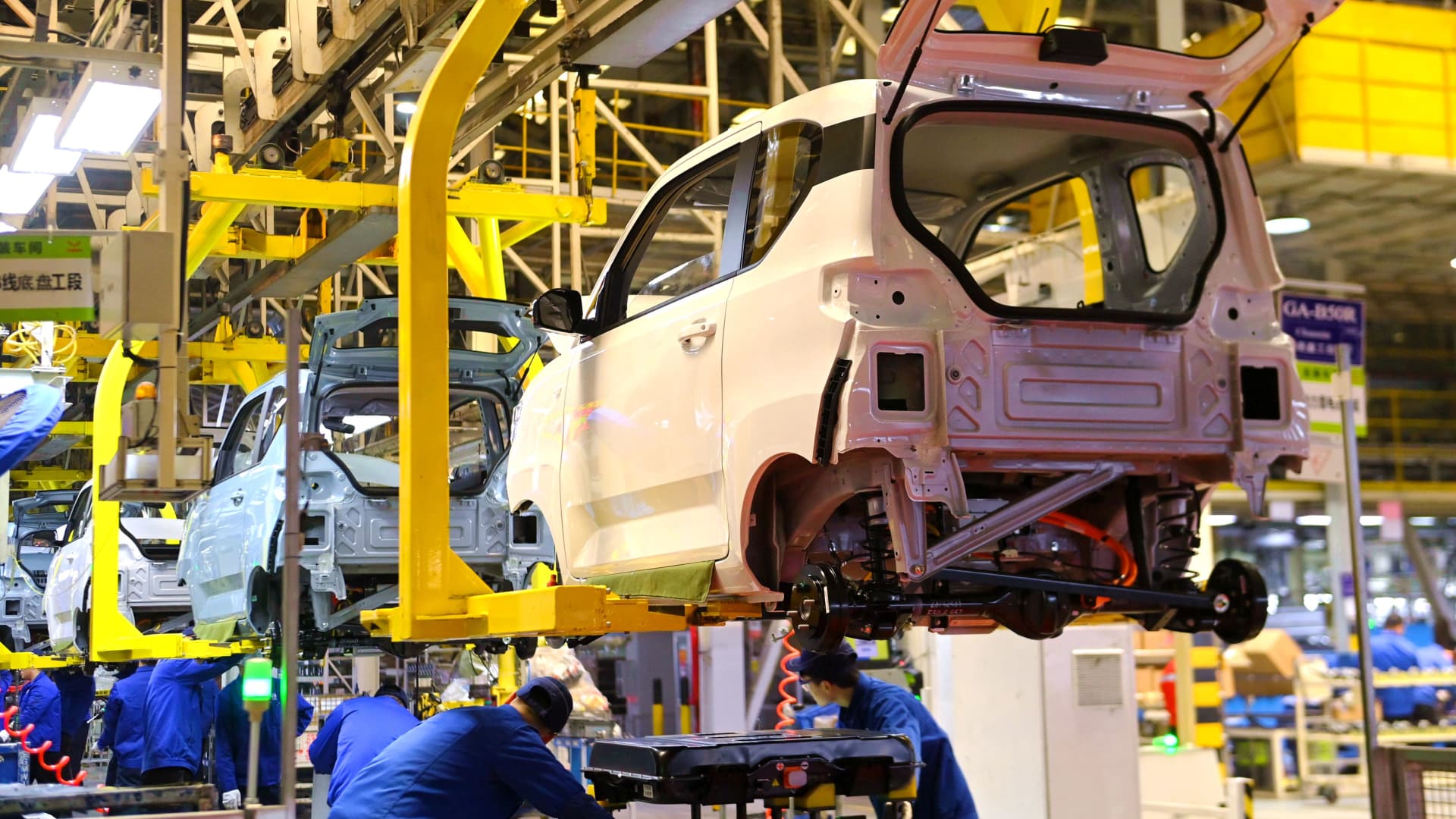They told us they were going to invest in EV R&D back in 2014. You know, back before we had that orange anal experience of a Russian puppet wannabe pornstar felon president. We put 6b into GM to compete; they pumped their stocks with it. Such is 3rd world America. Lay off the McCarthy bullshit whining about investing in R&D to mask corruption and ineptitude. This was no fucking surprise. Spinning this bullshit is just trying to justify screwing over average Americans with overpriced undeveloped bloated unaffordable garbage made to pad our useless incompetent oligarchy’s pockets.
If the western political classes hadn’t corruptly subsidized the fossil fuel oligarchy with trillions of dollars since WW2, the west would be leading the world in clean energy tech. Instead, exactly as expected, the same politicians and oligarchs who made fossil fueled warming an existential threat to life on Earth are continuing to hamstring the clean energy transition and deflect blame, by screaming “China bad”.
The corporate oligarchy would prefer to sow the seeds of fascism, nationalism, and xenophobia than allow legitimate democracy, make fewer profits, or give workers a fair share. They proved that when they outsourced as much as possible to China, and other authoritarian states.
Is it time to disprove CSIS claims again?
Here’s what CSIS claims for the 2009-2023 period:
$65.7B buyer rebates
$117.6B tax exemptions
$4.5B infrastructure subsidies
$25B research and development
$18B government procurement
Rebate estimates are based on published rates for qualifying vehicles and assume that 25% of EVs sold were not eligible. Rebate estimates prior to 2023 assume local government support amounted to 15% of central government support. The sales tax exemption is calculated using the stated 10% tax exemption for qualifying NEVs. Infrastructure subsidy estimates are based on funding amounts provided by the Ministry of Science and Technology. R&D estimates use government-funded R&D statistics and assume that 90% of auto R&D expenditure went towards NEVs. Government procurement estimates assume that 50% of government procurement of autos went towards NEVs. Estimates assume that the average prices of commercial and passenger vehicles are RMB 1.2 million and RMB 250,000, respectively. Annual currency conversions were done using exchange rate data from the OECD.
According to the 2020 policy, only passenger EVs costing less than RMB 300,000 (US$42,376) per unit are eligible for the fiscal incentives.
Let’s backtrack these numbers:
200 billion RMB in total subsidies. 14.1 million in total PEV stock as of 2022, giving ~14.2k RMB/car in subsidies. The top selling EV in China in 2022, the BYD Song, sells for about 180k RMB.
CSIS claims that subsidies are on the order of $230 billion, or 1.67 trillion RMB, but includes 2023 sales (total PEV stock of ~22 million). That’s a subsidy of ~76k RMB/car.
We know that the maximum buyer rebates were cut from 18k RMB in 2020 to 14.4k RMB in 2021 and 12.6k RMB in 2022 (but only for very high range EVs). Let’s assume for a second that China claims 200 billion RMB solely from buyer rebates, and that of the remaining 1.47 trillion RMB, 853 billion RMB came from the purchase tax… At a 10% tax rate, that suggests an average car value of ~390k RMB or ~54k USD. That exceeds the average car value of US car sales (~47k USD).
Clearly, CSIS has some wonky numbers, but where do they come from?
Well, if you were paying attention, CSIS claims are alarmingly close to China’s claims… If you convert to RMB. China claimed that the purchase tax exemption was responsible for a 115 billion RMB subsidy, while CSIS claimed a $117.6 billion subsidy. Due to differences in annual accounting standards, this is entirely possible.
To check, let’s work back based on China’s claims, assuming that the only subsidies China considers are buyer rebates and purchase tax exemptions (because funding research, funding infrastructure, and government procurement are hardly subsidies in China’s accounting). That leaves $85 billion RMB in buyer rebates and $115 billion RMB in tax exemptions. Working back from the known buyer rebates rate (assuming ~14k RMB/car average over all sales), this gives 6 million subsidy-eligible EV sales or an average sale price of 190k RMB.
However, we know that China’s total PEV stock by 2022 was 14.1 million, so what gives? Well, turns out hybrids are still considered PEVs in that accounting (despite receiving far lower subsidies), and the number of BEVs has only really ramped up recently. Moreover, for a variety of reasons not all EVs are eligible for subsidies.
In my next comment I’ll dive into where I think CSIS went wrong.
Rebate estimates are based on published rates for qualifying vehicles and assume that 25% of EVs sold were not eligible.
This eligibility rate seems high based on what we know of the EV market in China.
These were the rebates for 2022:
-
All-electric plug-in cars with a range over 400 km are eligible for subsidies of RMB 12,600 (approximately $2000).
-
All-electric plug-in cars with a range of 300–400 km are eligible for subsidies of RMB 9100 (approximately $1400).
-
Plug-in hybrid cars are now eligible for subsidies of RMB 4800 (approximately $750).
-
All-electric plug-in cars with a range of less than 250 km are no longer eligible for subsidies.
For example, the 118k RMB BYD Dolphin has a range of 301km, the 32k RMB Wuling Hongguang Mini EV has a range of 120km, and… Wait, hold up, the what now? The Mini EV is the best-selling car in China, has shipped 1.2 million units as of February 2023, and costs WHAT? The Mini EV market in China is huge, and assuming only 25% of sales aren’t captured by rebates seems… low?
Rebate estimates prior to 2023 assume local government support amounted to 15% of central government support.
This might be high, might be low, whatever. It’s a marginal error.
The sales tax exemption is calculated using the stated 10% tax exemption for qualifying NEVs.
This ignores the tax exemption caps, but since most EVs are under the cap price it’s fine I guess.
Infrastructure subsidy estimates are based on funding amounts provided by the Ministry of Science and Technology.
Can’t be bothered to check this.
R&D estimates use government-funded R&D statistics and assume that 90% of auto R&D expenditure went towards NEVs.
Wait, WHAT? Are they ignoring that China has many massive SOEs that have been building ICE cars for forever?
Government procurement estimates assume that 50% of government procurement of autos went towards NEVs.
Again, see above.
Estimates assume that the average prices of commercial and passenger vehicles are RMB 1.2 million and RMB 250,000, respectively.
Again, see the Mini EV.
Annual currency conversions were done using exchange rate data from the OECD.
Fine.
It’s clear then where the issues come from: a gross misunderstanding of the Chinese EV market, the average EV cost, and the maximum eligible tax exemption.
China claims $28 billion USD up to 2022 and another $72 billion up to 2027 (almost entirely vehicle tax exemptions)… Of course, those vehicle tax exemptions were inherently because of the pollution of ICE vehicles and only applied to the domestic market.
-
CSIS like most of our “think tanks” is also a barely disguised lobbying group that pretends to be something more.
Investment in public transport would have been better, but it’s not nothing. Hope other countries follow suit.

Oh definitely. I was just hoping they’d spend those billions on busses, metros and, yes, HSR, instead of on EVs. Still, they’re ahead of most countries as it is.
China has more infrastructure than what it needs. What they should do instead is not have their entire population as slaves. What does economic growth mean if the population earns almost no money. They don’t even consume the products they produce, almost all of it is exported. They are billions of people, it’s not like there’s a lack of demand, they just don’t have the money to buy what they produce.
ahead of all* countries
https://en.wikipedia.org/wiki/List_of_metro_systems and sort by system length

The fact that Moscow Metro is up there despite Moscow being so fucking cold is wild
$230 billion? But at what cost?





